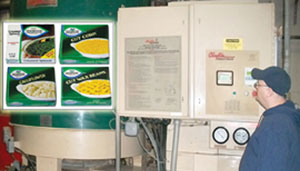Steam generators put deep freeze on food packer’s energy costs
When Charles F. Seabrook purchased the south New Jersey farm from his father in 1912, he wanted Seabrook Farms to be a pioneer in the growing, storing and selling of fresh, healthy vegetables. He made his farm one of the first ever to use overhead irrigation and gasoline-powered tractors and then expanded the farm to include a canning and freezing facility. For more than 100 years, that pioneering spirit has positioned the farm and Seabrook Brothers and Sons as a leader in the frozen vegetable business. Today, the fourth generation of the Seabrook Family contracts with farmers in six states, and processes and freezes 150 million pounds of vegetables in the Garden State each year, still operating with the same vision.

|
| Wes Seabrook stands next to the PLC-based controls of the Clayton Steam Generator, which provides steam on demand for processing Seabrook Farms’ vegetables. Inset: Seabrook frozen products have been around for decades. Source: Clayton Industries |
To most shoppers, the name Seabrook Farms is synonymous with crisp, frozen green beans and frozen, creamed spinach, but a large part of the business at Seabrook is actually the processing and freezing of vegetables for other manufacturers. About 34 years ago, that part of the business had the potential to blossom. But in keeping with its pioneering spirit, Seabrook knew that to meet higher demand and increased volume, the company would have to get ahead of the industry curve and find ways to process and freeze higher quantities faster and more efficiently.
Seabrook Farms felt it was time to upgrade the boilers it used for flash steaming, cooking and freezing. The old, energy-inefficient boilers could no longer provide the quantities of steam needed on a timely basis.
Wes Seabrook, vice president of engineering at Seabrook Brothers and Sons, opted for Clayton Industries high-efficiency Steam Generator to replace its old boilers. The choice was simple: “These steam generators could do what no boiler could—bring steam up to the right temperature so quickly that the quality of the fresh vegetables never became compromised,” says Seabrook.
The steam generator provides an extremely high fuel-to-steam efficiency, is compact in size and responds to needs very quickly. The main advantage is efficiency (typically more than 80%, whether natural gas, propane or oil fired), but other features meshed with Seabrook’s needs: fuel costs are lower; startups are immediate; and the needed vegetable steam temperature of 200° F can be achieved in two minutes.
In addition, the steam generator handles load shifts almost instantaneously. Therefore, Seabrook can process a small quantity of corn and immediately follow up with a large quantity of beans.
“The switch from a traditional boiler to the Clayton Steam Generator was just what the company needed to stay ahead of the times,” says Seabrook. The steam generator is a once-through, forced-flow, water-tube boiler using a steel helical coil heat exchanger. The generator contains three main components: the helical coil heat exchanger, a positive displacement feedwater pump and the mechanical steam separator. The unit features low NOx burner systems and PLC-based control.
For more information:
John Clayton, 800-423-4585, jclayind@aol.com
Looking for a reprint of this article?
From high-res PDFs to custom plaques, order your copy today!




